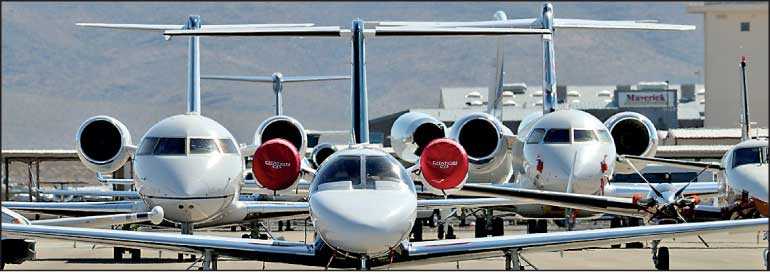Saturday Apr 19, 2025
Saturday Apr 19, 2025
Monday, 11 May 2020 00:00 - - {{hitsCtrl.values.hits}}

Storing something as complex as a modern aircraft is not easy. Before the pandemic, even an airplane that was not expected to be flying in the immediate short-term would be connected to a power source and undergo routine maintenance
Sri Lankans of a certain age would remember the crippling recession in the 1970s. A combination of the oil crisis and socialist economic policies saw a rapid destruction of wealth and widespread unemployment. The middle class of the country was practically wiped out, and many assets became almost worthless.
Among the hardest hit were car owners. With petrol prices skyrocketing, countless vehicles were stored in garages, propped up on logs to preserve their tyres.
The airline industry is facing a similar dilemma today, but on a much greater scale.
 Where do you store an aircraft?
Where do you store an aircraft?
An exact estimate of how many aircraft are in long-term storage is uncertain, but with less than 36% of flights operating compared to a year ago, the numbers of grounded airplanes are very large. Probably somewhere between 14,000 and 16,000 are inactive due to the pandemic.
Most are parked at the main base of their owner airlines. But, increasingly, others are being moved to long-term storage facilities. An aircraft sitting on the ground does not generate revenue, so airlines try to keep them airborne as much as possible; ‘utilisation’ is the magic number that powers airline revenue. A long-haul aircraft could be airborne for up to 20 hours a day and even smaller short-haul machines would spend 12 to 16 hours aloft on any given day. At more recently constructed airports spare ‘ramp space’ has been kept to a minimum, as no one foresaw an operational slowdown of this magnitude. Older airports have some space for parking idle aircraft, but many airlines are being forced to fly their airliners to dedicated independently operated storage facilities.
The world’s best-known aircraft storage bases are in the western deserts of the USA, in the states of California, New Mexico and Arizona, for example, where the US Air Force built huge facilities in the 1950s. The dry climate and ample space at these desert airports are ideal for storing the hundreds of aircraft parked there, some obsolete but many current types as well.
Europe’s largest dedicated airplane storage facility, at Teruel Airport in Spain, can handle as many as 250 large aircraft. France has several smaller facilities, through which Airbus cycles new airplanes depending on delivery dates. Australia has a recently opened storage facility at Alice Springs in the country’s ‘red centre’. In common with many other aircraft storage locations, the low humidity at Alice Springs is a key factor in preventing or minimising corrosion, one of the greatest threats to a mothballed airliner.
But dry climate alone does not turn an airport into a suitable storage site overnight. Maintenance personnel and equipment are vital to ensuring that aircraft are maintained correctly.
How do you store an aircraft?
Storing something as complex as a modern aircraft is not easy. Before the pandemic, even an airplane that was not expected to be flying in the immediate short-term would be connected to a power source and undergo routine maintenance. Aircraft are profusely equipped with electronics, which are best kept constantly powered.
Engines, the most expensive component on aircraft, also need continuous care. Windy conditions will cause the large fan in front to ‘windmill’, which normally is not a problem. But in the long-term this will cause wear and tear on the fan blades and bearings. Consequently, large protective caps are often attached to the front of engine cowlings to prevent wind damage during idle periods. If storage is long-term, engines are occasionally started and run through a sequence of tests before being secured again. Any exterior openings or hatches must be protected to prevent ingress of insects, dust and grit. Or to deter birds from building nests in convenient cavities, as recently happened to a Qantas aircraft. These coverings are in turn checked regularly to ensure they are intact. Most control surfaces are powered by hydraulic systems pressurised up to 5,000 psi (pounds per square inch). The hydraulic fluid lines require checking for leaks and draining to prevent clogging. Additionally, hydraulic reservoirs need topping-up and occasional purging before being refilled. Even the landing gear requires checking, with all tyres rotated and kept inflated with nitrogen. Occasionally, the aircraft is jacked up and its wheels cycled through retraction and extension to ensure that all is functioning correctly. Maintenance crews must comply with routine Service Bulletins (SBs) that detail modifications and repairs deemed necessary by the manufacturer. These are usually performed when an airplane enters the hangar, but must now be done in the open storage environment.
An app to the rescue
The massive number of airplanes currently grounded compounds the routine maintenance tasks needed. Accordingly, manufacturer Airbus has rushed out an app for this purpose. It provides a list of stored aircraft by tail number (registration) and identifies the routine work necessary daily to keep an airplane operationally ready. The app even has location data, so mechanics can find the particular aircraft requiring attention among the hundreds on site.
Once the travel industry starts recovering, the aircraft can be reintroduced to service in a phased manner. But only after a series of checks and test flights confirm each airplane’s fitness to return to the skies. We all pray that day will come soon.
(Comments may be sent direct to [email protected]. This and other writings are available on the author’s blog https://surenratwatte.com/blog/.)
Discover Kapruka, the leading online shopping platform in Sri Lanka, where you can conveniently send Gifts and Flowers to your loved ones for any event including Valentine ’s Day. Explore a wide range of popular Shopping Categories on Kapruka, including Toys, Groceries, Electronics, Birthday Cakes, Fruits, Chocolates, Flower Bouquets, Clothing, Watches, Lingerie, Gift Sets and Jewellery. Also if you’re interested in selling with Kapruka, Partner Central by Kapruka is the best solution to start with. Moreover, through Kapruka Global Shop, you can also enjoy the convenience of purchasing products from renowned platforms like Amazon and eBay and have them delivered to Sri Lanka.
Discover Kapruka, the leading online shopping platform in Sri Lanka, where you can conveniently send Gifts and Flowers to your loved ones for any event including Valentine ’s Day. Explore a wide range of popular Shopping Categories on Kapruka, including Toys, Groceries, Electronics, Birthday Cakes, Fruits, Chocolates, Flower Bouquets, Clothing, Watches, Lingerie, Gift Sets and Jewellery. Also if you’re interested in selling with Kapruka, Partner Central by Kapruka is the best solution to start with. Moreover, through Kapruka Global Shop, you can also enjoy the convenience of purchasing products from renowned platforms like Amazon and eBay and have them delivered to Sri Lanka.